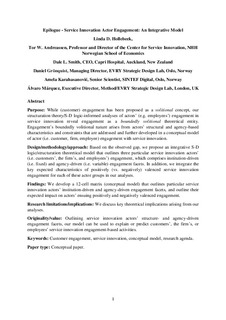Epilogue - Service Innovation Actor Engagement: An Integrative Model
Hollebeek, Linda D.; Andreassen, Tor Wallin; Smith, Dale; Grönquist, Daniel; Karahasanovic, Amela; Marquez, Alvaro
Peer reviewed, Journal article
Accepted version
Permanent lenke
http://hdl.handle.net/11250/2489440Utgivelsesdato
2018Metadata
Vis full innførselSamlinger
- Articles (SOL) [143]
- Publikasjoner fra CRIStin (NHH) [249]
Originalversjon
https://doi.org/10.1108/JSM-11-2017-0390Sammendrag
Purpose: While (customer) engagement has been proposed as a volitional concept, our structuration theory/S-D logic-informed analyses of actors’ (e.g. employees’) engagement in service innovation reveal engagement as a boundedly volitional theoretical entity. Engagement’s boundedly volitional nature arises from actors’ structural and agency-based characteristics and constraints that are addressed and further developed in a conceptual model of actor (i.e. customer, firm, employee) engagement with service innovation. Design/methodology/approach: Based on the observed gap, we propose an integrative S-D logic/structuration theoretical model that outlines three particular service innovation actors’ (i.e. customers’, the firm’s, and employees’) engagement, which comprises institution-driven (i.e. fixed) and agency-driven (i.e. variable) engagement facets. In addition, we integrate the key expected characteristics of positively (vs. negatively) valenced service innovation engagement for each of these actor groups in our analyses. Findings: We develop a 12-cell matrix (conceptual model) that outlines particular service innovation actors’ institution-driven and agency-driven engagement facets, and outline their expected impact on actors’ ensuing positively and negatively valenced engagement. Research limitations/implications: We discuss key theoretical implications arising from our analyses. Originality/value: Outlining service innovation actors’ structure- and agency-driven engagement facets, our model can be used to explain or predict customers’, the firm’s, or employees’ service innovation engagement-based activities.
